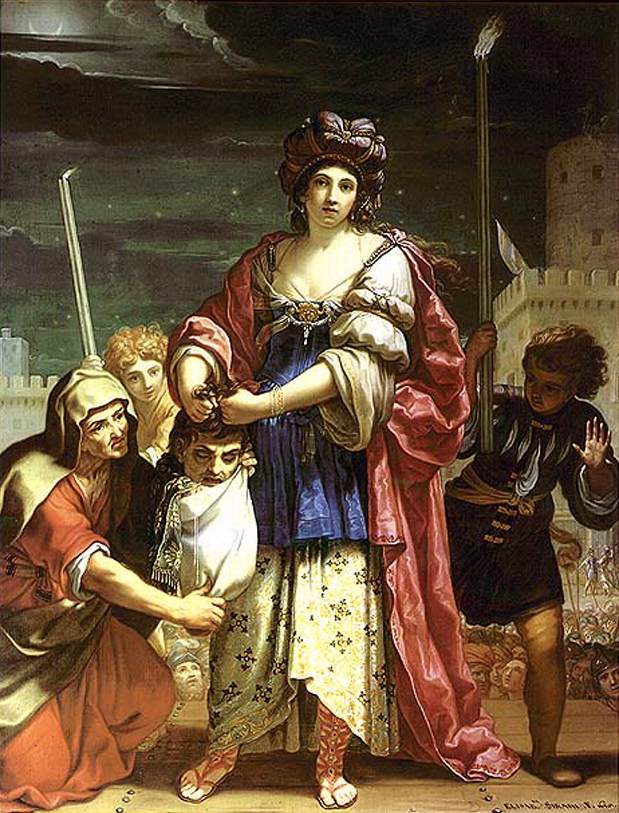Judith and Holofernes: 2 Target or trophy

Yesterday, in the first of these two articles showing paintings telling the Biblical story of Judith’s murder of Nebuchadnezzar’s general Holofernes, I concentrated on the moments of his beheading, that were popular in the early seventeenth century. Today’s selection covers scenes before that, when Holofernes became Judith’s target, and afterwards with her display of the severed head as a trophy.
Giorgione (1477–1510), Judith (c 1504), oil on canvas transferred from panel, 144 x 66.5 cm, Hermitage Museum, Saint Petersburg, Russia. Wikimedia Commons.
Judith from about 1504 has become one of the more secure attributions to Giorgione’s hand. It’s an unusual and brilliantly painted full-length portrait of the Biblical Judith, with her left foot resting on Holofernes’ severed head, much as a hunter might have done with a trophy.
Lucas Cranach the Elder (1472–1553), Judith with the Head of Holofernes (c 1530), oil on lime, c 86 × 55.7 cm, Kunsthistorisches Museum, Vienna, Austria. Wikimedia Commons.
In about 1530, Lucas Cranach the Elder painted Judith with the Head of Holofernes, where she brandishes the sword and her victim’s head while showing no emotion on her face.
In the middle of the seventeenth century, a third major woman painter, Elisabetta Sirani, painted this story at least twice.
Elisabetta Sirani (1638–1665) after Giovanni Andrea Sirani (1610–1670), Judith with the Head of Holofernes (date not known), oil on canvas, 129.5 x 91.7 cm, Walters Art Museum, Baltimore, MD. Wikimedia Commons.
Her undated Judith with the Head of Holofernes was apparently painted after a work of her father’s. Here, Judith appears reluctant to look at the severed head of Holofernes as she places it in the meat bag brought by her old maidservant.
Elisabetta Sirani (1638–1665), Judith with the Head of Holofernes (1658), oil on canvas, 236 x 183 cm, Lakeview Museum of Arts and Sciences, Peoria, IL. Wikimedia Commons.
Her own and more original treatment is shown in Judith with the Head of Holofernes from 1658. Set outside in the night, Judith stands bright and bold, staring with a look of slight disdain towards the viewer.
In 1819, when he was decorating the walls of his villa Quinta del Sordo with his Black Paintings, Francisco Goya included this story.
Francisco Goya (1746–1828), Judith and Holofernes (1819-23), oil on plaster transferred to canvas, 146 x 84 cm, Museo Nacional del Prado, Madrid, Spain. Wikimedia Commons.
Goya’s Judith and Holofernes is a relatively restrained depiction, showing Judith preparing to bring Holofernes’ sword down on his own neck, as her maid prays.
Horace Vernet (1789–1863), Judith and Holofernes (study) (1828/1832), oil on canvas, 26 x 33.5 cm, Museum of Fine Arts, Houston, TX. Wikimedia Commons.
Further into the nineteenth century, Horace Vernet made a study for an unusual treatment. Instead of showing the action immediately prior to, during, or following Holoferne’s beheading, he pictures Judith at her moment of peripeteia, the sword in her right hand, gazing at Holofernes and wondering whether she should kill him.
His model for Judith was Olympe Pélissier (1799-1878), a society hostess who had an affair with Honoré de Balzac in 1830, and later became the second wife of Gioachino Rossini, the Italian composer. In the end, Vernet seems to have abandoned this more psychological approach for an alternative composition, which he then exhibited at the Salon in 1831.
It wasn’t until the end of the nineteenth century that this story underwent a revival in visual art.
Jules LeFebvre (1834–1912), Judith (1892), oil on canvas, 92.5 x 61 cm, location not known. Wikimedia Commons.
Renowned or vilified for his nudes, Jules LeFebvre’s paintings included many in which his subjects were clothed, and his Judith from 1892 is one of the most interesting. He shows a proud and powerful figure holding a huge sword. From her helmet-like headdress to her heavy bronze belt she is every bit a warrior. In his portraits, LeFebvre favoured two poses: looking straight at the viewer, or head in profile looking to the right; here he uses the latter to reinforce Judith’s strength. His brushwork has also loosened significantly, at the edge of her black hair and in her clothing in particular.
Next came Gustav Klimt, who showed little interest in the murder, and more in Judith as a seductress and woman of strength.
Gustav Klimt (1862–1918), Judith I (1901), oil on canvas, 84 × 42 cm, Österreichische Galerie Belvedere, Vienna, Austria. Wikimedia Commons.
Klimt’s approach was influenced by his decorative experience, and returned to using gold leaf in what therefore became known as his Golden Phase. In his Judith I from 1901 he emphasises her neck with a broad gold choker studded with gems, and echoed in a golden belt at the foot of this painting.
Gustav Klimt (1862–1918), Study for Judith II (c 1908), media not known, 54.2 x 34.5 cm, Leopold Museum (Die Sammlung Leopold), Vienna, Austria. Wikimedia Commons.
A few years later, Klimt started work on a second version of Judith, for which he made this study in around 1908. This elevated view is a novel idea, and her origins as a dancer are apparent here, blurring Judith with Salome and the beheading of John the Baptist.
In narrative terms, the confounding of these two stories may seem odd. In Judith and Holofernes, Judith is a good character who uses seduction as a means to a worthy end, and her joy is derived from her success in beheading the enemy general. In Salome and John the Baptist (after it was reframed by Moreau and Oscar Wilde), Salome is the evil seductress, whose erotic dance is used to induce Herod to have the good person beheaded; her joy is in having her own way, and in the martyrdom of a man who had rebutted her advances. At the time though, both stories were becoming blurred in a sequence of dance by a seductress leading to the beheading of their partner, far from the Biblical origin of either.
Gustav Klimt (1862-1918), Judith II (Salome) (1909), oil on canvas, 178 x 46 cm, Ca’Pesaro, Galería de Arte Moderno, Venice. Wikimedia Commons.
Indeed Klimt’s finished painting of Judith II from 1909 shows his composite Judith/Salome bare-breasted, with the head of Holofernes/John at the lower right, its eyes closed. As in Judith I, at least her head appears to have been modelled by Adele Bloch-Bauer, and shows a state of near-ecstasy.
Koloman Moser (1868–1918), Judith and Holofernes (1916), oil on cardboard, 49.5 x 37.9 cm, Die Sammlung Leopold, Vienna, Austria. Wikimedia Commons.
Painted in 1916, in the middle of the First World War, Koloman Moser’s Judith and Holofernes could be based on the Biblical account, or perhaps on Alexander Serov’s opera Judith (1863). Set in the enemy general’s tent, he lies in a drunken stupor, as the naked Judith prepares to decapitate him.
Franz von Stuck (1863–1928), Judith and Holofernes (1927), oil on canvas, 82 × 74 cm, Private collection. Wikimedia Commons.
I finish with Franz von Stuck’s Judith and Holofernes, painted in 1927, the year before his death. Here the artist has chosen the moments in which Judith prepared to swing the heavy sword, with Holofernes lying on the bed in his drunken stupor. The simplicity of the scene results in a powerful image, heightened by red patches anticipating bloodshed.
In more than three centuries, the moment shown had moved but a few minutes in time.


